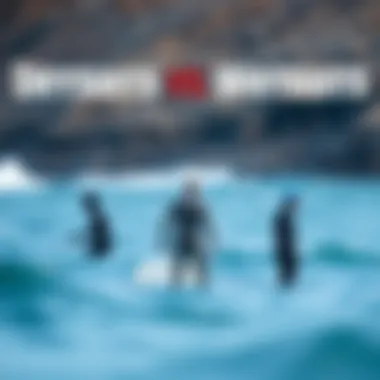Understanding Drysuits vs. Wetsuits for Kiteboarding


Intro
When it comes to navigating the waves and catching the wind, choosing the right gear can make or break your experience on the water, especially for kiteboarding. Two options often come into play: drysuits and wetsuits. While they both serve the purpose of keeping you warm, the distinctions between them run deeper than surface qualities. This guide aims to dissect the core differences, ensuring that you can make an informed choice about which thermal garment suits your kiteboarding escapades.
Understanding the nuances not only enhances your comfort but can also significantly affect your performance and safety during those exhilarating rides across the water. Buckle up as we dive into the details!
Gear Insights
Latest Gear Reviews
In the ever-evolving landscape of watersports gear, both drysuits and wetsuits continue to receive updates in tech and design. Let's take a closer look.
- Drysuits: Modern drysuits, such as those from Bare and GUL, utilize advanced materials that offer improved breathability and flexibility without compromising waterproof integrity. The Bare Nexgen model, for instance, features a lightweight yet robust construction ideal for a range of conditions.
- Wetsuits: Likewise, wetsuits have seen their share of innovation. Brands like O'Neill and Rip Curl have released suits equipped with lightweight neoprene, enhancing heat retention while allowing for easier movement. The O'Neill Psycho Tech is renowned for its exceptional warmth and flexibility in chilly waters.
Understanding the latest gear can aid you in tailoring your outfit perfectly to match both your comfort and the climatic conditions.
Essential Gear for Beginners
For those just starting their kiteboarding journey, having the right suit is critical.
- Wetsuit Recommendation: Beginners may find that a full wetsuit, like the Rip Curl Dawn Patrol, which provides ample warmth and flexibility, is a practical choice for a range of temperatures.
- Drysuit Consideration: If you're based in colder regions or plan to kiteboard in winter, investing in a drysuit such as the Kokatat Meridian can offer warmth and keep you safe from the biting chill.
Taking the leap into kiteboarding can be daunting, but with the right gear, it can turn into an exhilarating pursuit.
When it comes to choosing between a drysuit and a wetsuit, consider not just the conditions you plan to ride in but also how often you expect to get wet.
Closure of Gear Insights
Ultimately, whether you prefer the snug embrace of a wetsuit or the protective barrier of a drysuit, being well-informed will enhance your experience and ability on the water. Dive in and discover which offering best meets your preferences—there's a whole world of kiteboarding waiting for you!
Prologue
In the world of water sports, particularly for enthusiasts like kiteboarders, understanding the distinctions between drysuits and wetsuits is paramount. These thermal garments not only influence comfort and safety but also play a critical role in shaping the overall experience on the water. With the vast range of conditions one might encounter—from sunny, warm beaches to frigid, stormy waters—the right choice can be the difference between an enjoyable outing and a challenging ordeal.
Choosing between a drysuit and a wetsuit isn’t just about personal preference or style; it reflects a deeper understanding of how these suits function and the environments they are crafted for. Drysuits offer a watertight barrier, while wetsuits provide flexibility and insulation through a different mechanism. Knowing these differences allows individuals to make informed decisions, ensuring they are equipped for their specific adventures.
This article will tackle the fundamentals, starting from the basic definitions and designs of each option to their respective benefits in various conditions. We want you to be well-prepared, bustling with knowledge, when deciding what to wear while engaging in your favorite water sports. As you read on, it’s important to keep in mind not just the practical aspects of these suits, but also how they can enhance your connection with the water itself, allowing you to push your limits and truly enjoy the breathtaking experiences life on the waves offers.
Overview of Thermal Protection in Water Sports
Wetsuits and drysuits serve a vital purpose in thermal protection, enabling adventurers to stay safe and comfortable while exploring aquatic environments. Understanding how these suits function will put you in a better position to decide which one meets your needs in specific situations.
When you immerse yourself in water, your body loses heat much faster than it does in air. This heat loss is exacerbated as water temperatures drop, affecting your ability to maintain core body warmth. Here’s where thermal garments come into play. Both drysuits and wetsuits are designed to combat this issue, although they accomplish it via different methods.
In a wetsuit, the material, usually made from neoprene, traps a thin layer of water between your skin and the suit itself. This water gradually warms up due to your body heat, providing insulation as you move. The suit allows for a degree of water exchange, which generally makes it best suited for milder conditions.
On the other hand, drysuits are made from waterproof materials that keep water entirely at bay. They feature seals at crucial points such as the wrists and ankles, thereby creating a barrier against the cold water. This means you can layer up with thermal undergarments inside, effectively customizing your insulation based on the temperature.
"The best thermal protection comes from knowing the conditions and choosing attire that complements those conditions."
In essence, whether you’re navigating the warm, breezy waters of summer or the chilly depths during off-peak seasons, understanding the mechanics of thermal protection helps you make wiser decisions. Don't forget the significance of layering and achieving a snug fit as these elements contribute significantly to your thermal comfort.
The Basics of Drysuits


In the realm of water sports, especially for activities like kiteboarding, understanding the tools at your disposal can mean the difference between comfort and discomfort, or even safety and danger. Drysuits stand out as a specialized garment providing protection against cold water, making them a crucial piece of equipment for those venturing into chilly waters.
Being equipped with a drysuit allows the wearer to enjoy longer, more efficient sessions on the water. This section aims to elucidate the core aspects of drysuits, outlining their definition, purpose, construction, advantages, and when to use them effectively.
Definition and Purpose
A drysuit is a waterproof, insulated garment designed to keep the wearer dry and warm in cold aquatic environments. Unlike wetsuits, which allow water to enter and form a warming layer against the skin, drysuits are sealed off, creating a barrier against the elements. This design serves a dual purpose: maintaining thermal comfort in frigid conditions and safeguarding the user from hypothermia.
Drysuits are not just for the hardcore, die-hard adventurers. Many recreational kiteboarders and water enthusiasts find them necessary for longer excursions where the temperature control is paramount. The term 'drysuit' can sometimes be misleading, as while they prevent water entry, they do not provide insulation by themselves. It's common for individuals to wear thermal layers underneath to achieve optimal warmth.
Construction Materials and Design
When it comes to construction, drysuits typically are made from materials like nylon or neoprene, which are enhanced with waterproof coatings. The design includes waterproof zippers, seals around the neck and wrists, and often integrated boots or socks to ensure no water can sneak in.
Design Features:
- Neck and Wrist Seals: These are often made of latex or neoprene and are essential for keeping water out. A good fit is necessary to maintain warmth.
- Waterproof Zippers: A critical element to allow for ease of dressing while keeping the moisture at bay.
- Reinforced Knees and Elbows: Many models come with these for added durability, especially important for activities that involve kneeling or frequent movements.
Advantages of Drysuits
The overwhelming advantage of drysuits lies in their ability to maintain a dry microclimate around the body. Several benefits include:
- Extended Cold Weather Use: Drysuits allow enthusiasts to comfortably participate in water sports in conditions that would typically be too cold.
- Increased Safety: The ability to maintain core body temperature reduces the risk of hypothermia, which is crucial for any water enthusiast.
- Versatile Options: Many users can layer their clothing beneath the drysuit, adapting to the specific temperature and activity level.
Best Situations for Drysuit Usage
Understanding when to reach for a drysuit is just as important as knowing how to use it. The following situations are ideal for drysuit application:
- Cold Weather Conditions: If the weather is chilly or the water temperature is low, a drysuit is a must; typically below 10 degrees Celsius (50 degrees Fahrenheit) is a good benchmark.
- Prolonged Exposure to Water: Activities like long-haul kayaking or extended kiteboarding sessions often necessitate protection from the elements over time.
- High-Impact Activities: In scenarios where there’s a greater chance of falling into the water, the protection a drysuit provides can be invaluable.
"Choosing the right gear is pivotal; in many cases, drysuits can mean the difference between a fun day out and a frozen nightmare."
Ultimately, understanding the ins and outs of drysuits helps individuals make informed choices about their gear. That knowledge not only enhances their safety but allows them to immerse themselves fully in the experience of their favorite water activities.
The Essentials of Wetsuits
Wetsuits have find a special place in the hearts of water sports enthusiasts, especially among kiteboarders. These garments don't just provide warmth; they act like a second skin, enhancing performance while also offering protection. In this section, we'll dive deep into what wetsuits are, their construction, and their advantages. Understanding these elements is pivotal for anyone involved in aquatic activities, enabling informed decisions when selecting the right suit.
Definition and Purpose
At their core, wetsuits serve a specific function: to provide thermal insulation and protect the body from various hazards found in water. They are made using neoprene, a synthetic rubber known for its insulating properties. When submerged, the wetsuit traps a thin layer of water between the fabric and the wearer’s skin. This water is warmed by body heat, effectively forming a barrier that retains warmth even in chilly waters.
But beyond thermal protection, wetsuits also offer buoyancy, which can assist in swimming. They act as a buffer against scrapes and marine life, giving the wearer peace of mind while they explore the aquatic world.
Construction Materials and Design
The materials and design of wetsuits are crucial to their functionality. Most wetsuits are primarily constructed from neoprene, which comes in various thicknesses, typically ranging from 2mm to 7mm. The thickness determines the suit's warmth, and thinner materials are preferable for warmer waters, while thicker ones are essential for colder temperatures.
Additionally, wetsuits vary in design, from shorty suits, which cover the torso and arms but leave the legs exposed, to full suits that provide coverage from neck to ankles. Some even have specialized features like reinforced knee pads and seamless construction for improved comfort. Proper fit is vital; a suit that is too loose can let in water, while one that is too tight can restrict movement.
Advantages of Wetsuits
Wetsuits come with a whole host of advantages:


- Thermal Insulation: They trap body heat, making it possible to stay in the water for extended periods, even when conditions are less than ideal.
- Buoyancy: The added buoyancy helps in swimming and can be particularly beneficial for beginners.
- Protection: They shield the wearer from sunburn, abrasions, and unwanted encounters with jellyfish or sharp reefs.
- Flexibility: Modern wetsuits are designed for maximum flexibility, ensuring movement isn’t hindered while engaging in activities like kiteboarding.
"A rubber suit can be your best ally against the cold, letting you ride waves longer and bolder."
Best Situations for Wetsuit Usage
Identifying the right conditions for wetsuit usage is key to maximizing their benefits. Typically, wetsuits are most effective when water temperatures are between 60°F to 75°F. In chillier conditions, such as late fall or early spring, thicker suits or thermal layers are advisable.
Here are some of the best scenarios for wearing a wetsuit:
- Coastal Waters in Spring/Fall: As rivers, lakes, or oceans cool, a wetsuit provides essential warmth while engaging in kiteboarding or surfing.
- Tropical Location During Winter: In places where temperatures stay high but the water may be cooler than expected due to currents, a wetsuit adds comfort.
- Recreational Activities: Activities like kayaking, snorkeling, or surfing can quickly lead to unexpected drops in temperature, making wetsuits quite useful.
With a comprehensive understanding of wet suits' definition, construction, advantages, and ideal conditions, kiteboarders, instructors, and adventurers can make well-informed choices about their thermal gear.
Comparative Analysis of Drysuits and Wetsuits
Understanding the finer points of drysuits and wetsuits is essential for anyone looking to enjoy water activities, particularly kiteboarding. The decision between these two garments isn't merely about personal taste; it’s deeply tied to safety, comfort, and effectiveness in various conditions. This section aims to dissect the distinctions and overlaps between drysuits and wetsuits, covering crucial elements that could inform your choice for optimal performance and enjoyment.
Thermal Protection Mechanisms
Both drysuits and wetsuits are designed to provide thermal protection, but they approach this goal from different angles. A wetsuit relies on water being trapped between the suit and the skin to provide insulation. As your body heats that little bit of water, it forms a warm layer that keeps you cozy. However, this system only works efficiently in moderately cool conditions; once you enter colder waters, the limited insulation becomes a liability.
In contrast, drysuits employ a different principle. They are built to keep water completely out, allowing you to add layers underneath for insulation. This means you can stay warm even in frigid conditions. Imagine putting on a drysuit with thermal undergarments when heading into icy waters—this layered approach ensures your core stays toasty, making it very effective in extreme temperatures.
"Drysuits serve as a barrier to outside elements; while wetsuits depend on existing conditions to keep you warm."
Water Resistance and Insulation Properties
When you consider water resistance, drysuits take the cake. Their waterproof design means you can tackle those choppy waves without worrying about water creeping in. Taped seams and specialized entry systems are common in drysuits, ensuring that you remain completely dry. However, be cautious: if they experience wear and tear, leaks can happen, leading to discomfort and hazards.
Wetsuits, on the other hand, are inherently less resistant to water intrusion. They allow some water inside, which isn’t a big issue when temperatures are mild. The insulation is primarily provided by the water that warms up against your body, but in extreme conditions, this approach can turn against you. The thicker the neoprene, the better the insulation—but comfort and flexibility can take a hit.
Comfort and Mobility
Mobility is another key difference. Drysuits, while protective, can sometimes feel cumbersome. The added layers and bulkiness may limit your movements, especially when doing intricate maneuvers on a kiteboard. However, newer designs have improved on this front, using lighter materials to enhance flexibility.
Wetsuits are often praised for their snug fit and flexibility, which allows for a more natural range of motion. The challenge lies in choosing the right thickness; going too thick may sacrifice comfort for warmth, while going too thin may expose you to chilly water.
Intended Activities and Conditions
In terms of application, wet suits are ideal for warmer waters, or for activities where you can expect a quick dip or splash. Think of those summer kiteboarding sessions near the beach or a brisk surf. They excel in environments where temperatures allow for quick drying and limited exposure to cold.
Drysuits shine in harsh conditions. Whether you’re kitesurfing far from shore in the icy North Atlantic or embarking on an expedition in the frigid waters of the Arctic, these suits give you the peace of mind you need to explore without hesitation.
Temperature Considerations
When it comes to aquatic adventures, understanding temperature considerations can make or break your experience. Whether you're kiteboarding on a chilly morning or taking a dip in slightly warmer waters, the right thermal protection is essential for both comfort and safety. Knowing how temperature affects your choice between a drysuit and a wetsuit is foundational for ensuring that your time spent in the water remains enjoyable, regardless of the conditions.
Both drysuits and wetsuits have unique capabilities when it comes to thermal protection, and these capabilities are profoundly influenced by water temperature. The specific qualities of each suit determine how well they preserve warmth and regulate body heat, which can reduce fatigue and enhance performance in the water.
In this section, we delve into optimal temperature ranges for both drysuits and wetsuits. Understanding temperature considerations isn't just about comfort; it can help you make savvy decisions about gear, potentially saving you from frostbite in chilling waters or overheating on warmer days.
Optimal Temperature Ranges for Drysuits


Drysuits shine in extremely cold temperatures, making them a favorite among serious adventurers and professionals. They’re primarily designed to keep water out, creating a barrier that allows the wearer to use insulating layers beneath the suit. Generally, drysuits are most effective when water temperatures drop below 50°F (about 10°C). Many enthusiasts utilize them in conditions as cold as 32°F (0°C) and sometimes even lower, particularly when worn with thermal undergarments.
Here are some key points regarding drysuit usage in various temperature ranges:
- Subzero to 40°F (about 4°C): Ideal for icy waters where mobility is essential yet keeping warm is paramount. Users should wear appropriate thermal layering.
- 40°F to 50°F (about 10°C): In this range, the drysuit provides excellent thermal protection, allowing for extended comfort during vigorous activities.
- 50°F to 60°F (about 15°C): While drysuits remain effective, consider personal heat generation and suits' bulk, as they can lead to overheating.
The versatility of drysuits makes them especially valuable in environments with unpredictable weather. When the breeze picks up or the swell changes, having a well-fitted drysuit can offer protection from chilly winds, ensuring that kiteboarders can focus on their activity without diverting energy to regulate their body temperature.
Optimal Temperature Ranges for Wetsuits
In contrast, wetsuits operate on a different principle: they allow a thin layer of water to enter the suit, which is then warmed by your body heat. This makes wetsuits better suited for temperate waters. They excel in temperatures ranging from 50°F to 70°F (about 10°C to 21°C).
To gain a clearer picture, consider the following temperature ranges for wetsuit use:
- 50°F to 60°F (about 10°C to 15°C): A 4/3mm or thicker wetsuit is often recommended. Users might feel a chill initially, but the insulating effect soon takes over.
- 60°F to 70°F (about 16°C to 21°C): A 3/2mm wetsuit commonly suffices. Comfort levels increase, and activities can be enjoyed with minimal concern about warmth.
- Above 70°F (about 21°C): Many kiteboarders may prefer a shorty or even a rash guard for warmth regulation.
It’s essential for enthusiasts to listen to their own bodies and adjust their gear according to how they feel in the water. A solid understanding of temperature considerations can ultimately determine how well you enjoy the experience. The right choice can keep you focused on the waves, not worrying about the cold clutches of nature.
"Choosing the right thermal gear is more than just a matter of comfort; it's about empowering yourself to explore the elements without restraint."
Maintenance and Care
When engaging in water sports like kiteboarding, proper maintenance and care of your thermal garments, whether they are drysuits or wetsuits, can significantly extend their lifespan and enhance your on-water experience. While it may seem like a chore to some, neglecting to properly store and clean these suits can lead to wear and early replacement, costing both time and money. Understanding the nuances of care for each type of suit is essential for enthusiasts who value both functionality and investment.
Care Instructions for Drysuits
Drysuits often come with special materials designed to keep you completely dry, but these materials also require specific care to ensure they perform well over time. Here’s what you should keep in mind:
- Rinse Thoroughly After Use: After every use, especially if you’ve been in salt water, ensure you rinse your drysuit with fresh water. Salt can deteriorate the fabric and seals over time.
- Inspect for Damage: Regularly check for any wear and tear, especially around zippers, seams, and seals. If you notice leaks, it’s vital to address them promptly.
- Dry Properly: Hanging your drysuit inside out at room temperature is best. Avoid direct sunlight to prevent UV damage to the materials. Use a hangar that supports the suit adequately, avoiding any folding that could lead to creases.
- Store Correctly: When not in use, keep your drysuit in a cool, dry place, preferably inside a breathable garment bag. This will prevent moisture buildup and protect against mold or bacteria.
- Use Mild Detergents: Cleaning your drysuit every few uses with a mild, non-abrasive detergent can keep it fresh and remove any residual salts or dirt.
Care Instructions for Wetsuits
Wetsuits require a different kind of attention, primarily because they are designed to retain water for insulation. Their maintenance hinges on a few key pointers:
- Rinse with Fresh Water: Like drysuits, you should rinse your wetsuit in fresh water to remove any salt or chlorine. This prevents harmful buildups and fabric deterioration.
- Avoid Stretching the Neoprene: When putting on or taking off your wetsuit, be gentle. Stretching the material excessively can lead to tears or loss of insulation properties.
- Dry Inside Out: Drying your wetsuit inside out helps eliminate moisture and odor. Again, avoid direct sunlight as it can degrade the neoprene material.
- Do Not Fold: Instead of folding, hang your wetsuit using a wide hanger to avoid creasing, which can compromise insulation.
- Store Flat if Possible: If space permits, store your wetsuit flat in a cool, dry area to maintain its shape and integrity. Avoid leaving it bunched up because it can cause creasing or weakening of the seams.
Remember: A well-maintained suit translates to better performance. Whether you're free riding on the waves or tackling challenging conditions, the right care ensures that your gear supports you for as long as possible.
With these care instructions, kiteboarders and water sport enthusiasts alike can enjoy not just a comfortable ride, but also peace of mind knowing their gear is in good shape and ready for their next adventure.
For additional tips and discussions on gear maintenance, consider checking resources like reddit.com/r/waterports or diving into the information available on wetsuits.org.
Ending
Deciding between a drysuit and a wetsuit can feel like navigating a maze for many kiteboarding enthusiasts. Each suit has unique characteristics that cater to specific needs, making it crucial to understand their distinctions. This article has provided a detailed exploration of both options, allowing readers to weigh their advantages and disadvantages.
Making an Informed Choice
First and foremost, it’s essential to consider the temperature of the water where you plan to ride. Drysuits do a stellar job of keeping you insulated and preventing water from entering, making them ideal for chilly waters. On the other hand, wetsuits are more suited for warmer conditions where some water influx is tolerable, as they are designed to trap a layer of water that warms up with your body heat.
Additionally, assess the activities you intend to partake in. If you’re aiming for intense, cold-weather kiteboarding, a drysuit might just be your best ally. However, if you're looking to enjoy sunny days on the water, a wetsuit gives the freedom and flexibility needed for maneuvering through the waves.
It's also wise to factor in comfort and mobility. Drysuits tend to be bulkier, which can limit movement, whereas wetsuits provide a snug fit and allow dynamic movement—important for those tight turns and jumps.
Moreover, budget considerations should influence your decision. Drysuits usually require a bigger investment, so it's worth considering if you will get enough use out of it.
"Choosing the right suit can elevate your kiteboarding experience significantly, enhance your comfort, and ultimately set the stage for a thrilling adventure on the water."
In sum, understanding the core differences and applications of drysuits versus wetsuits equips you to make a more informed choice. Each has its time and place, and knowing which one aligns with your needs can make all the difference in your time spent on the water.















